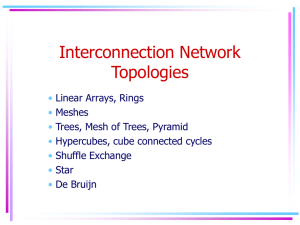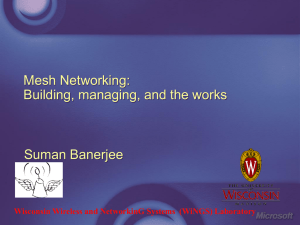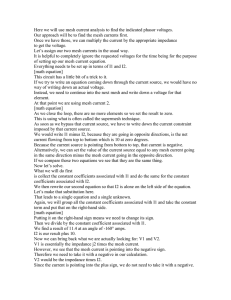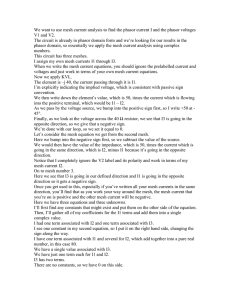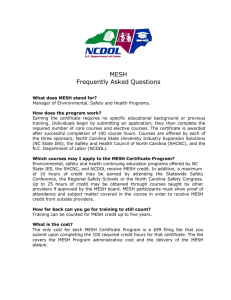HamWAN
advertisement
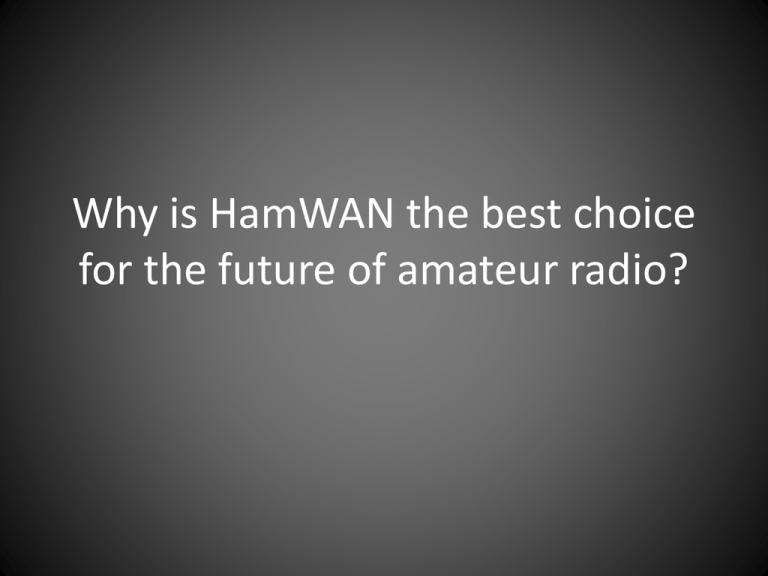
Why is HamWAN the best choice for the future of amateur radio? Regular 802.11 WiFi Behavior • • • • Based on Carrier Sense Multiple Access: CSMA Listen for completely silent channel before TX Shy about TX-ing. Can spend all time waiting. Performance problems in user-dense environments • Performance problems in any noisy environment Regular 802.11 WiFi Behavior • When all stations can’t hear each other, packets can collide in mid-air • Leads to more re-transmits and wastes airtime • This is exasperated in long-range links where nodes are spread out • All MESH networks suffer from these problems HamWAN uses TDMA • Time Division Multiple Access magically solves ALL of these problems MESH Does Not Scale • • • • Nodes spread out too thin? No one can hear each other. Nodes too dense? Too many radios CSMA contending for airtime and performance plummets. • There is a small window of “just right” that balances attenuation with propagation. HamWAN is Cellular • • • • Nodes spread out too thin? Shoot 40 miles to your closest cell site. Nodes too dense? User demand drives implementation of more, shorter-range cell sites. • Viable and consistently performing design over a broad range of application densities. MESH Does Not Scale • OK, we’ll add more high sites with MESH to avoid low density problems! • High sites have great propagation at microwave frequencies. • They’ll all share a frequency, hear each other, hear the city noise around them, be stuck CSMA waiting for access to airtime. • Performance plummets. HamWAN is Sectorized • 3 different channels on 3 different antennas always pointing in 3 different directions each covering 120 degrees of the horizon. • We can put up as many cell sites as we want and they never interfere with each other. • Usage of 3 sector frequencies also triples data throughput. • Ability to add more cells adds more data throughput capacity as needs dictate. MESH is Insecure • The tragedy is, only after money and effort has been spent to create a large network, will it become attractive enough for people to begin attacks. • Anyone leaking the shared key removes the only protection in place on the network. • Plugging the leak and changing the key are difficult processes taking a long time. • This is not like FM/VHF. Tracing microwave and detecting hacky activity is hard. HamWAN is Security Focused • A grand challenge in spectrum that can’t use encryption! • Users are authenticated using certificates. • Route announcements are limited per-user to registered address space. • Traffic is secured from injection / tampering with IPsec(AH). MESH is Public Access • Remember microwave data is not at all like voice. It’s not easy to identify non-hams by lack of callsign or voice pattern. • Once identified how do you prevent them from being on the ham network? It’s in Part 15 frequencies, they have a right to be there. • The root of the problem is lack of a mechanism to establish digital identity. HamWAN is a Ham Network • Users are issued certificates which contain their digital identity. • Network resources and access can be managed based upon this identity. • Operates in Part 97 frequencies, free of congestion from Part 15, easier to fox hunt. • This allows co-existence with WISPs. MESH Does Not Internet • 10.0.0.0/8 address space is not Internet routable by design. • Always stuck with hacky NAT solutions. • Makes peering with other networks really hard. • This is why a smooth interface between HamWAN and NW-MESH is difficult. HamWAN <3 Internet • • • • • Built using Internet-registered address space. Fully routed on the Internet right now! Try it: ping 44.24.240.78 When you connect, you get the same real IPs. Allows us to easily peer with other ham networks, like BCWARN (hi guys!) to extend network reach from Tumwater to Canada! • Full routing to all AMPR networks. HamWAN is Open to NW-MESH • But… • We cannot route 10.0.0.0/8 on HamWAN. • Which means people want tunnels between NW-MESH islands. • But if you spend all your time on 10.0.0.0/8, you isolate yourself from the rest of HamWAN and the Internet. • Life is much better on the Internet side. HamWAN Can Handle Emergencies • During an emergency, when the Internet goes down, alternative networks get swamped. • Quality of Service design allows emergency organizations to take priority on the network. • Designed to be completely autonomous. • Designed to handle link and site failures. • Users can multi-home. • Triple redundant network administration. Want to know more? • • • • • • • How do we measure radiation patterns? How do we measure frequency response? How does authentication work? How does roaming / mobility work? How does an uplink node work? What are the home LAN integration methods? How does DNS / DNSSEC work?


